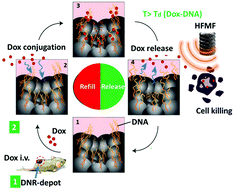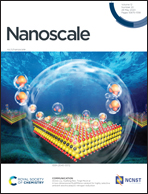Injectable DNA-architected nanoraspberry depot-mediated on-demand programmable refilling and release drug delivery†
Abstract
Drug delivery depots boosting a local concentration of therapeutic agents have received great attention in clinical applications due to their low occurrence of side effects and high therapeutic efficacy. However, once the payload is exhausted, the local drug concentration will be lower than the therapeutic window. To address this issue, an injectable double-strand deoxyribonucleic acid (DNA)-architected nanoraspberry depot (DNR-depot) was developed that can refill doxorubicin (Dox, an anticancer drug) from the blood and remotely control drug release on demand. The large porous surface on a uniform nanoraspberry (NR) filled covalently with DNA serves as a Dox sponge-like refilling reservoir, and the NR serves as a magnetic electrical absorber. Via the strong affinity between Dox and DNA molecules, the refilling process of Dox can be achieved on DNR-depot both in vitro and in vivo. Upon high-frequency magnetic field (HFMF) treatment, the remotely triggered release of Dox is actuated by the dissociation of Dox and DNA molecules, facilitating an approximately 800% improvement in drug concentration at the tumor site compared to free Dox injection alone. Furthermore, the cycles of refilling and release can be carried out more than 3 times in vivo within 21 days. The combination of refilling and HFMF-programmable Dox release in tumors via DNR-depot can effectively inhibit tumor growth for 30 days.



 Please wait while we load your content...
Please wait while we load your content...